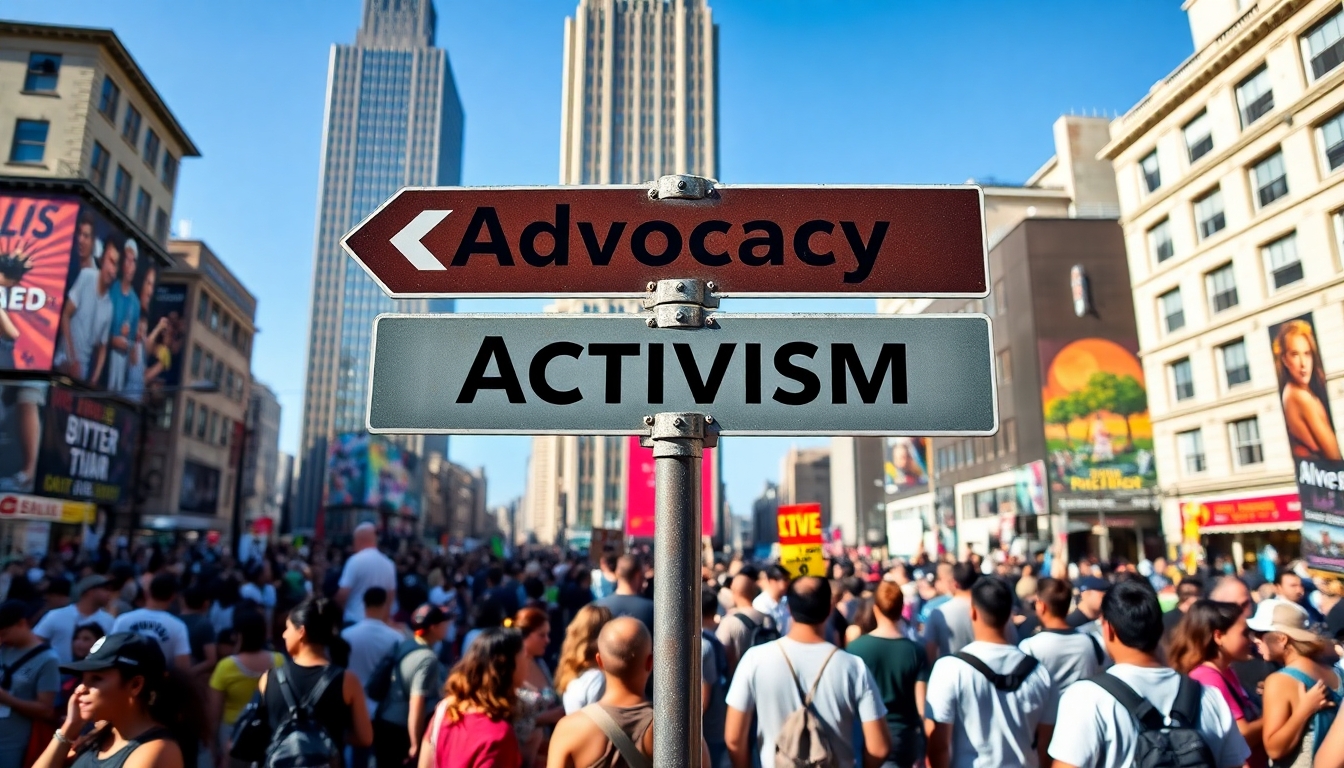When it comes to creating change in the world, the terms advocacy and activism often pop up. But what do they really mean? And how do they differ? These words are like two sides of the same coin, each playing a crucial role in the grand scheme of social change. Yet, they are not the same. Advocacy is like a gentle nudge, a whisper in the ears of those in power. It’s about using your voice to influence decisions and policies. Activism, on the other hand, is more like a shout. It’s about taking action, often in public, to bring attention to a cause. So, while both aim to achieve change, they do so in different ways.
Imagine advocacy as a strategic chess game. It involves careful planning, building relationships, and working behind the scenes. You’re lobbying, writing letters, or meeting with decision-makers. It’s about convincing those in power to see things your way. Activism, in contrast, is more like a game of soccer. It’s dynamic, energetic, and sometimes messy. You’re out there, organizing rallies, protests, or sit-ins. It’s about making noise and drawing attention to issues that matter. Both methods are important. And knowing when to use which can make all the difference.
So, why does this distinction matter? Because understanding these differences can help you choose the right approach for your cause. Whether you’re a student hoping to make a difference in your community or an organization aiming for broader social impact, knowing when to whisper and when to shout is key. By understanding the nuances of advocacy and activism, you can better navigate the complex world of social change. And ultimately, make a bigger impact.
Definitions: Advocacy vs. Activism
Imagine you’re standing at a crossroads, one path labeled advocacy and the other activism. They might seem like synonyms at first glance, but they lead to different destinations. Understanding these paths is crucial if you’re passionate about social change. So, what exactly do these terms mean?
Advocacy is like being the voice of reason in a room full of noise. It’s about speaking up for a cause, often in a more formal, structured way. Think of it as a gentle nudge to policymakers, urging them to consider changes. Advocacy often involves working within established systems. It’s about drafting policies, writing letters, or having calm discussions with decision-makers. It’s strategic and often works behind the scenes, like a chess player planning several moves ahead.
On the other hand, activism is the loud rallying cry that demands attention. It’s the protestors marching down the street, the signs waving high, and the chants echoing through the air. Activism is direct and immediate. It seeks to create a stir, to make people sit up and take notice. It’s about challenging the status quo and pushing for change through public action. Activism is often spontaneous and passionate, driven by the energy of those involved.
Both advocacy and activism have their unique roles and strengths. They are not mutually exclusive and often overlap, like two sides of the same coin. Understanding these differences helps us choose the right path for our causes, ensuring that our efforts are effective and impactful.
When to Use Advocacy vs. Activism
Deciding between advocacy and activism can feel like choosing between chocolate and vanilla. Both are delicious in their own way, but they serve different purposes. Advocacy is like a gentle nudge in the right direction, often involving behind-the-scenes work, like talking to officials or crafting policies. It’s about building relationships and creating a dialogue. Activism, on the other hand, is the fiery spirit of social change. It’s the rallies, the protests, the loud voices demanding to be heard. But when do you choose one over the other?
Consider your goals. Are you aiming for immediate change or long-term impact? Advocacy might be your best bet if you’re looking for sustainable, systemic shifts. It’s like planting a seed and nurturing it over time. However, if you’re seeking to draw attention to an urgent issue, activism’s your go-to. It’s the megaphone that amplifies voices, making sure the message is heard loud and clear.
Context matters too. Sometimes, the situation calls for the subtlety of advocacy, like when working with policymakers who prefer quiet negotiations. Other times, the urgency of the issue demands the boldness of activism. Think of it as a dance; sometimes you lead with advocacy, other times with activism, depending on the rhythm of the moment.
Ultimately, the choice between advocacy and activism boils down to the impact you want to make. Both have their strengths, and sometimes, they work best together. Like peanut butter and jelly, they complement each other, creating a powerful combination for social change. So, what’s your flavor? Are you the whisper of advocacy or the roar of activism?
Examples of Advocacy and Activism in Action
When it comes to creating change, both advocacy and activism have their unique flavors. Let’s dive into some real-world examples that highlight their distinct roles. Imagine a group of passionate individuals working tirelessly to change legislation. They might engage in advocacy by meeting with lawmakers, crafting policy papers, and organizing educational campaigns. Their goal? To influence decision-makers to adopt new laws or amend existing ones. It’s like planting seeds in a garden, hoping they’ll sprout into something beautiful.
On the flip side, activism often takes a more direct approach. Think of the historic civil rights marches, where people took to the streets to demand justice and equality. These actions were loud, visible, and impossible to ignore. Activists might organize rallies, sit-ins, or even boycotts to draw attention to pressing issues. It’s akin to a thunderstorm that shakes the earth, demanding immediate attention.
Consider the environmental movement. Advocacy groups might work behind the scenes, lobbying for stricter pollution controls and renewable energy incentives. Meanwhile, activists could be found chaining themselves to trees or staging protests at oil drilling sites. Both are essential, like two sides of the same coin, working towards the common goal of a healthier planet.
These examples show how advocacy and activism, though different, often complement each other. Like a well-rehearsed orchestra, they play different instruments but come together to create a harmonious symphony of change. Whether you’re more of a quiet gardener or a stormy force, both paths are vital in the journey towards social progress.
How They Complement Each Other in Social Movements
When it comes to driving social change, both advocacy and activism play pivotal roles. Imagine them as two sides of the same coin, each bringing unique strengths to the table. Advocacy often involves working within the system, using dialogue and negotiation to influence policy and decision-makers. It’s like planting seeds in fertile soil, hoping they’ll grow into meaningful change over time. On the other hand, activism is more like a thunderstorm, shaking things up with protests, rallies, and direct action to draw attention to pressing issues.
These approaches are not mutually exclusive. In fact, they often work best when combined. For instance, advocacy can lay the groundwork by raising awareness and building relationships with key stakeholders. Once the stage is set, activism can step in to amplify the message and create urgency. This dynamic duo can be seen in many successful social movements. Consider the civil rights movement in the United States, where advocacy efforts in the form of legal challenges and lobbying were complemented by the activism of marches and sit-ins.
In the end, the synergy between advocacy and activism can be the catalyst for profound social change. While advocacy provides the steady push needed to influence policy, activism delivers the passionate pull that captures public attention. Together, they create a balanced approach that can adapt to various challenges and opportunities within social movements. So, whether you’re more of a strategist or a firebrand, there’s a place for everyone in the fight for justice and equality.
Choosing the Right Approach for Your Cause
Deciding whether to use advocacy or activism for your cause can feel like standing at a crossroads. It’s not just about picking a path; it’s about understanding the landscape and knowing where you want to go. Think of it like choosing between a megaphone and a pen. Each has its place, but the choice depends on what you aim to achieve.
Advocacy is like a gentle tide, slowly but steadily shaping the shoreline. It’s about engaging with policymakers, crafting compelling arguments, and using data to persuade. If your cause needs a seat at the table, advocacy might be your best bet. It’s like being the calm voice of reason in a heated debate, offering solutions and building bridges.
On the other hand, activism is the storm that demands attention. It’s the rallying cry that echoes through the streets, the protest that disrupts the status quo. When the time calls for immediate action and visible change, activism takes center stage. It’s about making noise and refusing to be ignored, like a flash of lightning in a dark sky.
Sometimes, the best approach is a blend of both. Imagine advocacy as the roots of a tree, providing stability, while activism is the branches reaching high, visible to all. Together, they create a strong, unified movement. Consider your resources, your audience, and your ultimate goal. Whether you choose advocacy, activism, or a mix of both, ensure it aligns with your cause’s unique needs and objectives for meaningful change.
Frequently Asked Questions
- What is the main difference between advocacy and activism?
The primary difference lies in their approach. Advocacy involves promoting a cause through dialogue, education, and negotiation, while activism often includes direct action and protest to drive change. Think of advocacy as a gentle nudge and activism as a bold shout.
- When should I choose advocacy over activism?
Choosing advocacy is ideal when you seek to influence decision-makers through policy change or awareness campaigns. If you’re aiming for a more collaborative and less confrontational approach, advocacy is your go-to strategy. It’s like choosing a calm conversation over a heated debate.
- Can advocacy and activism be used together?
Absolutely! Advocacy and activism complement each other beautifully. While advocacy lays the groundwork with dialogue and policy influence, activism can amplify the message through direct action. It’s like having a dynamic duo working towards the same goal.
- Do you have examples of successful advocacy and activism?
Certainly! The civil rights movement is a prime example, where advocacy through legal challenges and activism through marches and protests worked hand in hand. It’s a testament to the power of both approaches working in harmony.
- How do I decide the best approach for my cause?
Assess your cause’s needs, available resources, and desired impact. Advocacy might be better for long-term policy change, while activism could be more effective for immediate attention. It’s like choosing the right tool for the job.

